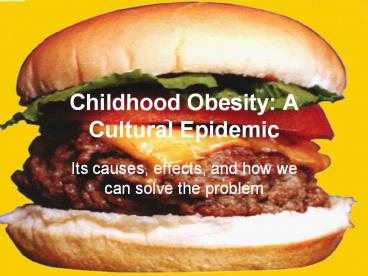Childhood Obesity: A Cultural Epidemic - PowerPoint PPT Presentation
1 / 25
Title:
Childhood Obesity: A Cultural Epidemic
Description:
Childhood Obesity: A Cultural Epidemic Its causes, effects, and how we can solve the problem What is Obesity? Though there is no ideal weight for everyone, a ... – PowerPoint PPT presentation
Number of Views:851
Avg rating:3.0/5.0
Title: Childhood Obesity: A Cultural Epidemic
1
Childhood Obesity A Cultural Epidemic
- Its causes, effects, and how we can solve the
problem
2
What is Obesity?
- Though there is no ideal weight for everyone, a
person is considered obese when his/her BMI is
over 30 - BMI is a persons Body Mass Index
3
Calculating BMI
- In addition to the numerous websites available to
calculate ones BMI, there is a formula - Weight(lbs)? (704.5)/(height(in))2
4
(No Transcript)
5
What makes a kid/teen overweight?
- Instead of using the word obese the Centers for
Disease Control refer to two markers for those
who are overweight - The 85th percentile is considered at risk,
corresponding to a BMI of 25 for adults - The 95th percentile is the more severe level of
obesity, corresponding with a BMI of 30 for
adults
6
8 Main Causesaccording to a study of 9,000
seven- year- olds
- High birth weight
- Obesity in one or both parents
- 8 hours of TV per week by age 3
- Larger size in early life, measured at 18 months
- Rapid weight gain in the 1st year
- Rapid catch up growth between birth and two
years of age - Less than 10.5 hours of sleep per night by age 3
- Early development of body fat in pre- school
children - Before age 5-6, when it should start increasing
7
- Though humorous, this cartoon reflects the
mentality of modern America
8
(No Transcript)
9
- Part of the reason for the marked increase in
obesity over the past 40 years is the shift in
the types of calories being consumed - 10 of caloric intake is from soft drinks, thats
double from what it was in 1980 - American children spend nearly 30 billion of
their own money annually on junk food, a result
of increased advertising specifically targeting
them - Since 1994, 600 new childrens food products have
been introduced, half of these being candies and
gum
10
There are many factors that can influence a
childs chances of becoming overweight
11
Recent studies have shown that one of the many
factors influencing the weight of children today
is their ethnicity
12
Frightening Food
- As time goes by, children have been consuming
increasing amounts of soft drinks, which contain
high amounts of sugar and calories devoid of any
nutritional value - 30 of the calories in an average childs diet
come from these junk foods - Some pediatricians estimate that many overweight
children may consume 1200 to 2000 calories per
day solely from soft drinks - In recent years, low income families are finding
it increasingly difficult to afford healthy foods
such as fruits and vegetables - The foods that are most convenient (fast food,
microwave meals, packaged snacks) are generally
less nutritionally valuable and highly processed
13
Two of the main causes of obesity exemplified
unhealthy food and a sedentary lifestyle
14
Enough Exercise?
- Suburban and Urban environments discourage
walking or biking to places, with increased
emphasis on riding in cars - Less opportunity for exercise in schools
- Leisure activities such as video games becoming
dominant over outdoor sports etc.
15
The many risks associated with being overweight
16
- Long term effects of obesity
17
- In this study, mothers of Australian pre-school
aged children were questioned concerning their
childrens weights and whether or not they would
consider them overweight currently
18
- This box an whisker plot reflects those mothers
from this same survey who were concerned about
their children being overweight in the future
19
What Can Be Done?
- Funding in schools can be increased in order to
allow for more nutritious school lunches - Allowing time for physical activities during
school hours - Instilling healthy eating and exercise habits in
children, starting with the parents - Encourage family out door leisure time as opposed
to video games or tv
20
(No Transcript)
21
- According to scientists in England, based on the
trends in recent years,by 2010, obesity rates in
adults will further increase, as shown in this
graph - This same British group estimates that if no
action is taken, obesity rates in children will
continue to increase at a frightening rate
22
(No Transcript)
23
(No Transcript)
24
- If nothing is done about this nationwide, and
even worldwide problem, we will have to deal with
the consequences of the ailments of our children
of today as they grow up to be our unhealthy
adults of tomorrow. It is essential that children
learn good habits now for better lives tomorrow.
25
Works Cited
- Anne Collins Weight Loss Program 2007. 20 Oct.
2007 lthttp//www.annecollins.com/weight-loss/body-
mass-index.htmgt. - ERIC Digest. American Association of Colleges
for Teacher Education. 1990. 20 Oct. 2007
lthttp//www.kidsource.com/kidsource/content2/obesi
ty.htmlgt. - Research Uncovers 8 Causes of Childhood
Obesity. Daily News Central. 20 May 2005. 19
Oct. 2007 lthttp//health.dailynewscentral.com/cont
ent/view/802/0gt. - Childhood Obesity in the United States Facts
and Figures.Institute of Medicine of the
National Academics. Sept 2004. Institute of
Medicine. 19 Oct. 2007 lthttp//www.iom.edu/Object.
File/Master/22/606/FINALfactsandfigures2.pdfgt. - The Role of Media in Childhood Obesity. Feb
2004. The Henry J. Kaiser Family Foundation. 20
Oct. 2007 lthttp//www.kff.org/entmedia/upload/The-
Role-Of-Media-in-Childhood-Obesity.pdfgt. - Haire-Joshu, Debra. Laura L. Hayman and Marian L.
Fitzgibbon. Childhood Obestiy Can Policy
Changes Affect this Epidemic? Society of
Behavioral Medicine. 2007. Society of Behavioral
Medicine. 19 Oct. 2007 lthttp//www.sbm.org/policy/
childhood_obesity.aspgt.































